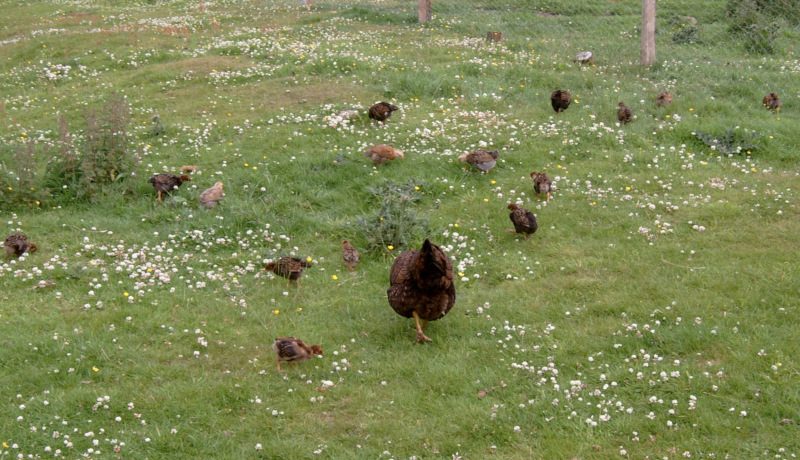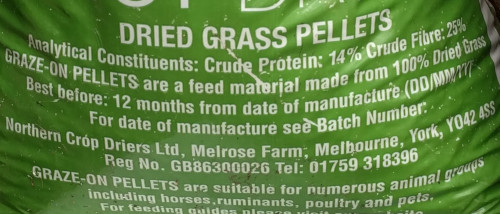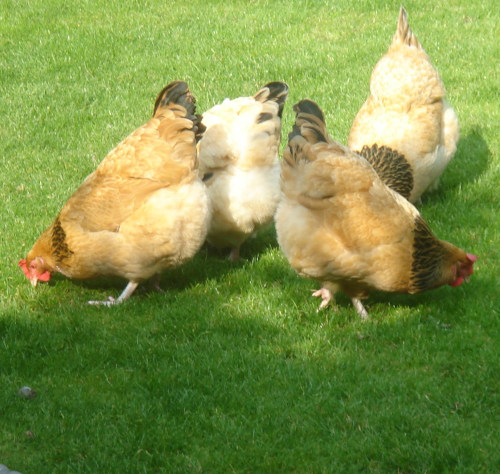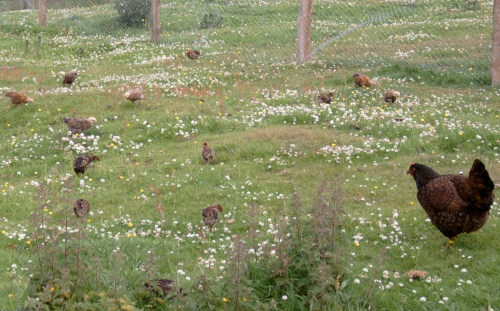Can and should chickens eat grass and is it good for them?

Both grass and grass seed is an essential part of the diet of chickens. Birds also find insects and grit among grasses while free ranging making it even more beneficial.
Table of Contents
- Do chickens eat grass?
- It is good for chickens to eat grass?
- Do chickens like grass?
- Can chickens eat only grass?
- What are the benefits of grass and pasture for chickens.
- Can chickens eat too much grass?
- Can you put grass in a chicken coop?
- What kind of grass do chickens like to eat?
- Can baby chicks eat grass?
- How to feed grass to chickens:
Do chickens eat grass?
Chickens do eat grass. I have spent a lot of time watching mine over the years and they all graze happily, preferring the new fresh green shoots to the older tougher grasses.
I am a great believer in pasture rearing all chickens.
Below: Here are my chickens eating grass.
If you watch carefully you can see how she nips the tender growing tips of the blades of grass.
Grass clippings are fine for chickens to eat as long as they have not been treated with pesticides, fertiliser or herbicides in the last 12 months.
Grass seed is an excellent chicken feed and mine spend summer eating as much of it a they can find.
Dried grass is fine for chickens in some circumstances. I buy dried grass pellets that need soaking in water and these are made from short green grasses.
Hay is long and tough and should never be given to chickens to eat.
Exactly how beneficial grass is for a chickens diet depends on the variety grow, the soil it grows in and the seasons.
It is good for chickens to eat grass?
It is good for chickens to eat grass provided it has not been treated with chemical pesticides, herbicides or fertilisers.
It is not only better for the chickens to eat grass, it is better for you. The American Pastured Poultry Producers’ Association carried out studies on the nutritional values of grass fed poultry and pastured eggs, and has found chickens with constant access to pasture to be more nutrient dense compared to non-pastured chicken and eggs, specifically in term of higher levels of omega 3 fatty acids and vitamins, A and E.
Below: Here is the nutritional analysis for the dried grass pellets I use in winter to supplement my chickens feed.

While it does depend on the season, species and where it is growing, grass has around 35 calories per 100 grams and contains 14% protein and 25% fibre. Minerals in grass vary with the conditions and the soil but include various elements like calcium, selenium and iron.
Below: This picture shows just how much grass chickens eat.

Forage grasses contain a high proportion of polyunsaturated fatty acids (PUFA). These ‘good’ lipids, better known as Omega 3 and Omega 9 fatty acids, have positive health effects for both the poultry and for humans.
Do chickens like grass?
Chickens do like grass. They like to be out and about on grass and they like to eat grass and they like to hunt through it to find bugs and other tasty morsels.
I found hundreds of pictures and video clips of my flock eating grass.
Below: Here are some of my chickens eating grass.
Chickens like to eat grass because they seem to know that grazing on greenery is good for variety in the diet.
Can chickens eat only grass?
No chickens can not survive eating only grass, they need a varied diet including protein, grains, greens, grit, calcium and other minerals, vitamins, salts, and water.
Grass can’t provide my chickens with all the protein or calcium needed and it is too high in fibre to be the only food for a flock.
Chickens thrive on variety and need a complete food in the form of layers pellets
What are the benefits of grass and pasture for chickens.
- Chickens on grass can indulge in natural scratching behaviours.
- Chickens kept on grass are happier and healthier.
- Grass is high in omega fats which are good for the chickens and make for more nutritious eggs.
- The egg yolks will be a deeper colour.
- Grass is rich in trace elements like iron and selenium.
- Chickens on pasture can get as much as one third of their calcium requirements met by grass.
- Pasture rearing can cut your feed bill by 25%.
- A flock on pasture can find bugs and grit.
- Above all the chickens like it.
Can chickens eat too much grass?
Chickens with a balanced diet and access to pellets or grains are unlikely to eat too much grass.
Chickens can eat too much grass especially if it is long, tough and fibrous. It is not long grass that is bad for chickens but the tough hay type grasses with thick stems.
Below: If your grass looks like this it may be too fibrous for chickens and cause crop problems.

The one big downside to grass is as it grows older it becomes more fibrous. The long fibrous strands can get stuck in chickens' crops and lead to sour crop or impacted crop.
Can you put grass in a chicken coop?
So in the good old days this was actually a thing! Every morning you would cut a large square of turf and put it in the coop or run for the chickens to peck at and scratch at all day and then at night you would take it out.
These days it is easier to grow a few trays of sprouts of fodder for your flock rather than go to the effort of digging great sods of earth out of the ground.
What kind of grass do chickens like to eat?
Chicken favourite grasses to eat are the short, tender and bright green types.
Below: Some Buff Sussex enjoying the lawn.

My fields have a mixture of specialist pasture grasses and clovers as well as a few other plants like wheat and barley that have grown from leftover scratch grains.
Can baby chicks eat grass?
Baby chicks can eat grass and their mother will show them how it is done. All my broody coop allow access to grass and are moved regularly.
Below: These chicks are around 4 weeks old and the are on pasture with their mother.

If they have been reared artificially they need to be introduced to green gradually from 2 to 4 weeks of age
How to feed grass to chickens:
Never feed grass that has been treated with fertiliser, pesticides or herbicides.
Don't give it all at once, spread it out over a couple of days.
Allow them to free range and eat as much as they want to.
Grow fodder in trays for the times when fresh grass is not available.
Cut grass strands into very small pieces shorter than 1 inch or even better, offer clumps of dirt and grass.
Try to cut more often so you get very young tender blades of grass instead of thicker, rougher blades.
